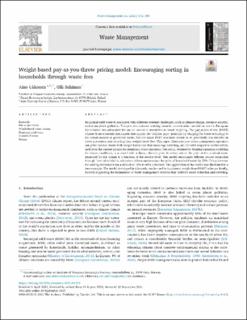| dc.contributor.author | Ukkonen, Aino | |
| dc.contributor.author | Sahimaa, Olli | |
| dc.coverage.spatial | Norway, Oslo | en_US |
| dc.date.accessioned | 2023-06-20T07:14:58Z | |
| dc.date.available | 2023-06-20T07:14:58Z | |
| dc.date.created | 2021-10-01T10:32:31Z | |
| dc.date.issued | 2021-09-30 | |
| dc.identifier.citation | Waste Management. 2021, 135 (November 2021), 372-380. | en_US |
| dc.identifier.issn | 0956-053X | |
| dc.identifier.uri | https://hdl.handle.net/11250/3072194 | |
| dc.description | Aino Ukkonen, Olli Sahimaa, Weight-based pay-as-you-throw pricing model: Encouraging sorting in households through waste fees, Waste Management, Volume 135, 2021, Pages 372-380, ISSN 0956-053X, https://doi.org/10.1016/j.wasman.2021.09.011 (https://www.sciencedirect.com/science/article/pii/S0956053X21005006) | en_US |
| dc.description.abstract | Municipal solid waste is associated with different systemic challenges, such as climate change, resource scarcity, and ocean plastic pollution. European countries are striving towards more circular material use and the European Commission has advocated the use of economic incentives to boost recycling. The pay-as-you-throw (PAYT) scheme is an economic instrument that applies the ‘polluter pays’ principle by charging for waste according to the actual amount of generated waste. Volume-based PAYT fees have shown to be potentially less effective in waste prevention and recycling than weight-based fees. This paper illustrates how waste management operators can price residual waste with weight-based fees that encourage recycling, are fair with respect to service levels, and cover the current income for municipal waste operators. The result, obtained by forming equations satisfying the above conditions, is a model with a linear, discrete price function, where the price of the residual waste generated by the citizen is a function of the service level. This model encourages efficient source separation through internal subsidies, wherein a citizen can decrease the price of household waste by 32% if they increase the sorting efficiency from a default of 40% to 80% efficiency. The application of the model was illustrated in a case example. The model developed in this study can be used to implement weight-based PAYT schemes locally, thereby supporting the formulation of waste management systems that facilitate waste reduction and recycling. | en_US |
| dc.language.iso | eng | en_US |
| dc.publisher | Elsevier | en_US |
| dc.rights | Navngivelse 4.0 Internasjonal | * |
| dc.rights.uri | http://creativecommons.org/licenses/by/4.0/deed.no | * |
| dc.subject | Pay-as-you-throw | en_US |
| dc.subject | Weight-based waste pricing | en_US |
| dc.subject | Municipal solid waste | en_US |
| dc.subject | Household waste | en_US |
| dc.subject | Sorting | en_US |
| dc.title | Weight-based pay-as-you-throw pricing model: Encouraging sorting in households through waste fees | en_US |
| dc.type | Journal article | en_US |
| dc.type | Peer reviewed | en_US |
| dc.rights.holder | © 2021 The Authors. Published by Elsevier Ltd. | en_US |
| dc.description.version | publishedVersion | en_US |
| cristin.ispublished | true | |
| cristin.fulltext | original | |
| cristin.qualitycode | 1 | |
| dc.identifier.doi | 10.1016/j.wasman.2021.09.011 | |
| dc.identifier.cristin | 1941997 | |
| dc.source.journal | Waste Management | en_US |
| dc.source.volume | 135 | en_US |
| dc.source.issue | November 2021 | en_US |
| dc.source.pagenumber | 372-380 | en_US |

